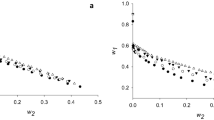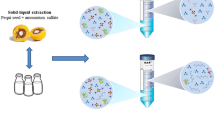Abstract
Statistical models concerning partitioning of pectinase in polyethylene glycol 1000/Na2SO4 aqueous two-phase system were established with response surface methodology. Concentrations of polyethylene glycol 1000 and Na2SO4 were selected as independent variables to evaluate their impact on parameters of partitioning in aqueous two-phase system—the partition coefficient of pectinase, purification factor and pectinase yield. An experimental space where over 2.5-fold purification was achieved, followed by over 90% yield of pectinase. The established models showed good prediction of partitioning parameters.


Similar content being viewed by others
References
Albertsson P-A (1986) Partition of cell particles and macromolecules, 3rd edn edn. Wiley, New York
Przybycien TM, Pujar NS, Steele LM (2004) Alternative bioseparation operations: life beyond packed-bed chromatography. Curr Opin Biotechnol 15:469–478
Andersson E, Hahn-Hagerdal B (1990) Bioconversions in aqueous two-phase systems. Enzyme Microb Technol 12:242–254
Zijlstra GM, de Gooijer CD, Tramper J (1998) Extractive bioconversions in aqueous two-phase systems. Curr Opin Biotechnol 9:171–176
Rito-Palomares M, Lyddiatt A (2002) Process integration using two-phase partition for the recovery of intracellular proteins. Chem Eng J 87:313–319
Jayani RS, Saxena S, Gupta R (2005) Microbial pectinolytic enzymes: a review. Process Biochem 40:2931–2944
Kashyap DR, Vohra PK, Chopra S, Tewari R (2001) Application of pectinases in the commercial sector: a review. Biores Technol 77:215–227
Li C, Bai J, Li W, Cai Z, Ouyang F (2001) Optimization of conditions for bacteriocin extraction in PEG/salt aqueous two-phase systems using statistical experimental designs. Biotechnol Prog 17:366–368
Marcos JC, Fonseca LP, Ramalho MT, Cabral JMS (2002) Application of surface response analysis to the optimization of penicillin acylase purification in aqueous two-phase systems. Enzyme Microb Technol 31:1006–1014
Mayerhoff YDVL, Roberto IC, Franco TT (2004) Purification of xylose reductase from Candida mogii in aqueous two-phase systems. Biochem Eng J 18:217–223
Zhi W, Song J, Ouyang F, Bi J (2005) Application of response surface methodology to the modeling of α-amylase purification by aqueous two-phase systems. J Biotechol 118:157–165
Li T, Wang N, Li S, Zhao Q, Guo M, Zhang C (2007) Optimization of covalent immobilization of pectinase on sodium alginate support. Biotechnol Lett 29:1413–1416
Miller GL (1959) Use of dinitrosalicylic acid reagent for determination of reducing sugar. Anal Chem 31:426–428
Bradford MM (1976) A rapid and sensitive method for the quantification of microgram quantities of protein utilizing the principle of protein-dye binding. Anal Biochem 72:248
R Development Core Team (2006) R: a language and environment for statistical computing, version 2.3.1 R Foundation for Statistical Computing Vienna, Austria
Selber K, Nellen F, Steffen B, Thommes J, Kula M-R (2000) Investigation of mathematical methods for efficient optimization of aqueous two-phase extraction. J Chromatogr B 743:21–30
Snyder S, Cole K, Szlag D (1992) Phase compositions, viscosities, and densities for aqueous two-phase systems composed of polyethylene glycol and various salts at 25°C. J Chem Eng Data 37:268–274
Lima A, Alegre R, Meirelles A (2002) Partitioning of pectinolytic enzymes in polyethylene glycol/potassium phosphate aqueous two-phase systems. Carbohydr Polym 50:63–68
Antov M, Peričin D, Pejin S (2004) Pectinases partitioning in aqueous two-phase systems: an integration of the systems poly(ethylene glycol)/crude dextran and poly(ethylene glucol)/ammonium sulphate. J Serb Chem Soc 69:299–307
Acknowledgments
This work was supported by grant number 142 046 from Ministry of Science, Republic of Serbia. Authors wish to thank Ms. Senka Mađarev for her excellent technical assistance.
Author information
Authors and Affiliations
Corresponding author
Rights and permissions
About this article
Cite this article
Antov, M., Omorjan, R. Pectinase partitioning in polyethylene glycol 1000/Na2SO4 aqueous two-phase system: statistical modeling of the experimental results. Bioprocess Biosyst Eng 32, 235–240 (2009). https://doi.org/10.1007/s00449-008-0243-3
Received:
Accepted:
Published:
Issue Date:
DOI: https://doi.org/10.1007/s00449-008-0243-3




